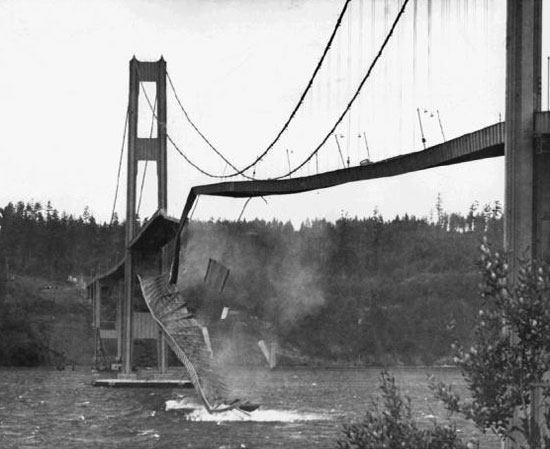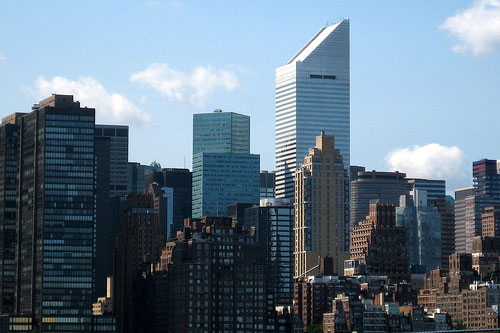Great works but ... 'fear of wind'
Please introduce to readers, 4 works that have resonated in the world but only partly from the magnificence level but mainly from the defects in design and unreasonable calculations make them become Lessons should be avoided.
Tacoma suspension bridge (USA) collapsed in 1940
This is one of the most famous design projects by which one can quickly verify that a suspension bridge can completely break down just because . strong winds.

The Tacoma Bridge crosses an 800 meter long river and at that time was the third longest suspension bridge in the world, just behind the Golden Gate Bridge (San Francisco, USA) and George Washington Bridge (New York, USA). With a compact and lightweight shape, this bridge is more flexible than many normal bridges and since the first winds, users have noticed the shaking of the bridge.
An engineer at the time thought of looking for ways to increase the certainty of the bridge and decided to return to the image of the bridge in November 1940. That day, the wind was very intense and the amateur filmmaker had the opportunity to capture impressive swaying scenes and images of the entire bridge collapsing into the river.
Citicorp Center (New York, USA), inaugurated in 1977, overcome the incident in 1978
The giant Citicorp was inaugurated in 1977. However, just one year later, chief engineer William LeMessurier rushed to find a solution to avoid the risk of the building collapsing. Previously, the construction of the building in this position had met with fierce and prolonged opposition from the clergy because they did not want to relocate a church in that area.

In the end, the missionaries only allowed the use of the church's upper space and this affected the design of this 59-story building. After construction, an architecture student warned LeMessurier that the building might be in danger if the wind was too big.
And fortunately, LeMessurier deployed the building reinforcement campaign just before a storm hit New York.
Millenium Bridge (England) temporarily suspended after 2 days of inauguration
Opened on June 10, 2000, the Millenium Bridge over the River Thames (London, England) was temporarily suspended for use only two days later because pedestrians felt dizzy and nauseous when crossing the bridge. . The cause of this problem is that the pedestrians tried to balance when walking on the bridge, due to the shaking phenomenon.

When building, the engineers designed to slightly bridge the wind. But the consequence is that only the lightest wind can shake the bridge. With many people on the bridge at the same time, this phenomenon became more pronounced and some people were worried about falling into the water.
Therefore, the engineers had to review and install a damping system for the bridge. But it was not until 2002 that the bridge was put to use again.
Kansai International Airport (Japan)
In the form of a battleship, Kansai International Airport is designed to come from the shape of Japan as a small island nation that is becoming overwhelmed by its large population. The airport is responsible for ensuring air traffic for the cities of Kobe and Osaka, so a huge construction area is needed and people have been thinking about having to fill the sea to build an airport.

The construction of an airport on an island near Osaka Bay began in 1987 with a huge amount of work: it took 3 years to pour mortar into the sea with 10,000 workers and 80 barges working non-stop to build an artificial island. But geologists were not aware that it was necessary to first treat the clay layer on the seabed in a compacted form and push the water out, like a sponge that needed to be drained.
By 1997, this artificial island had subsided to about 10 meters. Emergency reinforcements have allowed the airport to survive the 1995 earthquake (which happened in Kobe) and the terrible winds of the 1998 typhoon. However, up to now, this artificial island still subsidence about 30 cm / year.
- 7 most common fears in the world! Try reading if you have a friend in it?
- Fear of confusion
- 6 ways to help you control fear
- 8 bizarre fears of humans
- Strange fear syndrome that you may be suffering from but don't know how to call
- Pumps thanks to ... wind power
- Space elevator
- Number 13 and superstition fear
- 6 artificial works of Vietnam are honored by the world
- The baby alone played with snakes and the scientific solution behind it
- 14 huge modern works that change the world
- 10 things not everyone knows about the wind
 Norway built the world's tallest wooden tower
Norway built the world's tallest wooden tower Kremlin
Kremlin Ashurbanipal: The oldest royal library in the world
Ashurbanipal: The oldest royal library in the world Decoding the thousand-year construction of Qin Shihuang shocked the world
Decoding the thousand-year construction of Qin Shihuang shocked the world